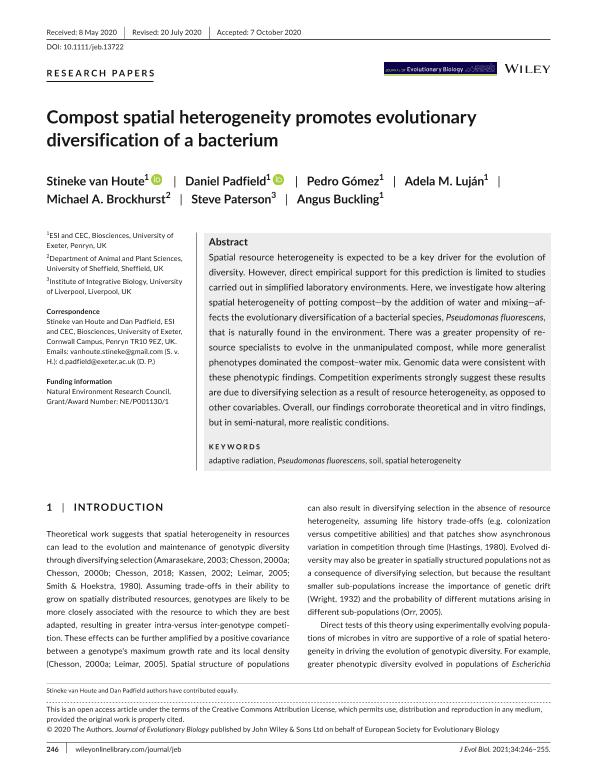Artículo
Compost spatial heterogeneity promotes evolutionary diversification of a bacterium
van Houte, Stineke; Padfield, Daniel; Gómez, Pedro; Lujan, Adela Maria ; Brockhurst, Michael A.; Paterson, Steve; Buckling, Angus
; Brockhurst, Michael A.; Paterson, Steve; Buckling, Angus
 ; Brockhurst, Michael A.; Paterson, Steve; Buckling, Angus
; Brockhurst, Michael A.; Paterson, Steve; Buckling, Angus
Fecha de publicación:
02/2021
Editorial:
Wiley Blackwell Publishing, Inc
Revista:
Journal of Evolutionary Biology
ISSN:
1010-061X
e-ISSN:
1420-9101
Idioma:
Inglés
Tipo de recurso:
Artículo publicado
Clasificación temática:
Resumen
Spatial resource heterogeneity is expected to be a key driver for the evolution of diversity. However, direct empirical support for this prediction is limited to studies carried out in simplified laboratory environments. Here, we investigate how altering spatial heterogeneity of potting compost—by the addition of water and mixing—affects the evolutionary diversification of a bacterial species, Pseudomonas fluorescens, that is naturally found in the environment. There was a greater propensity of resource specialists to evolve in the unmanipulated compost, while more generalist phenotypes dominated the compost–water mix. Genomic data were consistent with these phenotypic findings. Competition experiments strongly suggest these results are due to diversifying selection as a result of resource heterogeneity, as opposed to other covariables. Overall, our findings corroborate theoretical and in vitro findings, but in semi-natural, more realistic conditions.
Palabras clave:
ADAPTIVE RADIATION
,
PSEUDOMONAS FLUORESCENS
,
SOIL
,
SPATIAL HETEROGENEITY
Archivos asociados
Licencia
Identificadores
Colecciones
Articulos(IRNASUS)
Articulos de INSTITUTO DE INVESTIGACIONES EN RECURSOS NATURALES Y SUSTENTABILIDAD JOSE SANCHEZ LABRADOR S.J.
Articulos de INSTITUTO DE INVESTIGACIONES EN RECURSOS NATURALES Y SUSTENTABILIDAD JOSE SANCHEZ LABRADOR S.J.
Citación
van Houte, Stineke; Padfield, Daniel; Gómez, Pedro; Lujan, Adela Maria; Brockhurst, Michael A.; et al.; Compost spatial heterogeneity promotes evolutionary diversification of a bacterium; Wiley Blackwell Publishing, Inc; Journal of Evolutionary Biology; 34; 2; 2-2021; 246-255
Compartir
Altmétricas



